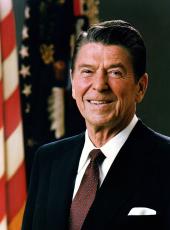By the President of the United States of America
A Proclamation
Over two hundred years ago, in June 1775, the first distinctive American flags were flown over the colonial defenses during the Battle of Bunker Hill. One flag was an adaptation of the British Blue Ensign, while the other displayed the pine tree, a symbol of the experience of Americans who had wrested their land from the wilderness.
As the colonials moved toward a final separation from Great Britain, other flags appeared. At least two of them featured a rattlesnake, symbolizing vigilance and deadly striking power. One bore the legend "Liberty or Death"; the other, "Don't Tread on Me." The Grand Union Flag was raised over Washington's Continental Army Headquarters on January 1, 1776. It displayed not only the British crosses of St. Andrew and St. George, but also thirteen red and white stripes to symbolize the American colonies. The Bennington flag also appeared in 1776, with thirteen stars, thirteen stripes, and the number "76."
Two years after the Battle of Bunker Hill, on June 14, 1777, the Continental Congress adopted a flag that expressed clearly the unity and resolve of the patriots who had banded together in the cause of independence. The delegates voted "that the flag of the thirteen United States be thirteen stripes, alternate red and white; that the union be thirteen stars, white in a blue field representing a new constellation."
After more than two centuries, with the addition of thirty-seven stars, each representing one of our 50 States, the flag chosen by the Continental Congress on that June day in Philadelphia still waves over our Nation. This flag symbolizes our shared commitment to freedom and federalism and carries a message of hope to the afflicted, of opportunity to the oppressed, and of peace to all humanity.
To commemorate the adoption of our flag, the Congress, by a joint resolution approved August 3, 1949 (63 Stat. 492), designated June 14 of each year as Flag Day and requested the President to issue an annual proclamation calling for its observance and for the display of the Flag of the United States on all government buildings.' The Congress also requested the President, by joint resolution approved June 9, 1966 (80 Stat. 194), to issue annually a proclamation designating the week in which June 14 occurs as National Flag Week and calling upon all citizens of the United States to display the flag during that week.
Now, Therefore, I, Ronald Reagan, President of the United States of America, do hereby designate June 14, 1986, as Flag Day and the week beginning June 8, 1986, as National Flag Week, and I direct the appropriate officials of the government to display the Flag of the United States on all government buildings during that week. I urge all Americans to observe Flag Day, June 14, and Flag Week by flying the Stars and Stripes from their homes and other suitable places.
I also urge the American people to celebrate those days from Flag Day through Independence Day, set aside by Congress as a time to honor America (89 Stat. 211), by having public gatherings and activities at which they can honor their country in an appropriate manner, especially by ceremonies in which all renew their dedication by publicly reciting the Pledge of Allegiance to the Flag of the United States of America and to the Republic for which it stands, one Nation, under God, indivisible, with liberty and justice for all.
In Witness Whereof I have hereunto set my hand this twelfth day of May, in the year of our Lord nineteen hundred and eighty-six, and of the Independence of the United States of America the two hundred and tenth.

RONALD REAGAN
Ronald Reagan, Proclamation 5476—Flag Day and National Flag Week, 1986 Online by Gerhard Peters and John T. Woolley, The American Presidency Project https://www.presidency.ucsb.edu/node/258950

